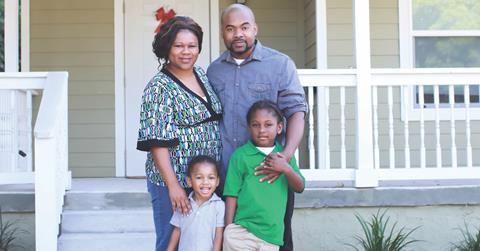- While the national unemployment rate hovers near 5.2% and locally near 5.4%, in the zip codes in which LISC Jacksonville is most active, the rate is closer to 12%.
- In the four council districts that LISC Jacksonville does the majority of its work, there are over 61,000 people living in poverty, which represents 41% of the total population living in poverty within Duval County.
In Jacksonville, Family Wealth Creation for LISC is centered around our work within three areas. First is our Financial Opportunity Centers (FOCs), which are career and financial coaching service centers that focus on the financial bottom line for individuals living with low-to-moderate incomes. The cornerstone of the FOC model is providing these services in an integrated way—rather than as stand-alone services—and with a long-term commitment to helping clients reach their goals, while simultaneously narrowing racial wealth gaps in historically under-resourced communities.
The second aspect of our work around Family Wealth Creation focuses on heir’s property. Our goal here is to help transfer generational wealth by assisting with financial and estate planning, probate, clearing titles, and consolidating property ownership. Our research has led us to discover that heirs face an increased risk of forced sale or eviction, cannot qualify for rehab programs or secure financing for needed repairs, and cannot qualify for loss mitigation programs when facing foreclosure. All of which can lead to deterioration of housing stock or loss of homeownership.
The final leg of our work relative to Family Wealth Creation focuses on home production. While LISC itself is not a developer, our role in creating family wealth centers on our ability to provide the necessary capital for developers to build affordable homes in areas that are underserved. This is of particular importance given that research continuously shows that purchasing a home tends to be the single largest investment that a person will make in their lifetime. To that end, over the next 12 – 18 months, LISC Jacksonville resources will be used to bring roughly 229 affordable housing units to the market, which includes Project Boots.
In the end, we recognize that the work of transitioning families out of poverty into sustainable lifestyles that afford them the ability to have options is not done alone nor in a vacuum. It takes a concerted effort on the part of several entities like United Way, Lift Jax, the Jessie Ball duPont Fund, the Community Foundation, the Delores Barr Weaver Legacy Fund and Lutheran Social Services, just to name a few who have come together.


 LISC’s investments in Historic Eastside do not represent a singular investment in a social program with the hopes that the people will somehow be better. Our investments in Historic Eastside represent a belief in the enterprises that have been tried and true in terms of disrupting the entanglements that poverty and lack of solid investments bring. During the last 10 years, LISC Jacksonville has invested in people, homes, and technical assistance to empower the people who are closest to the issue with the tools to be a part of the change they want to see. We have partnered with organizations ranging from the United Way to LIFT JAX to Operation New Hope to get the work done.
LISC’s investments in Historic Eastside do not represent a singular investment in a social program with the hopes that the people will somehow be better. Our investments in Historic Eastside represent a belief in the enterprises that have been tried and true in terms of disrupting the entanglements that poverty and lack of solid investments bring. During the last 10 years, LISC Jacksonville has invested in people, homes, and technical assistance to empower the people who are closest to the issue with the tools to be a part of the change they want to see. We have partnered with organizations ranging from the United Way to LIFT JAX to Operation New Hope to get the work done.